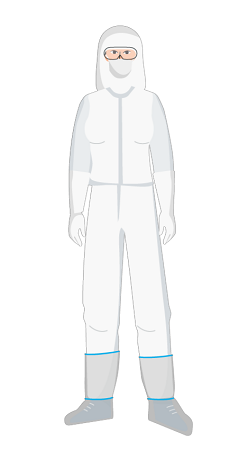Cleanroom apparel serves two functions.
First, cleanroom apparel encapsulates the operator to prevent contaminants from breathing, hair, skin, undergarments, street clothing, and shoes from migrating into the cleanroom environment. Since NEBB estimates that 70% of contamination is generated by the operator, selecting the right apparel to meet your cleanroom and operator requirements – and then training your operators on the proper use – are the determining factors in maintaining cleanliness in your facility.
Cleanroom Apparel Selection Fundamentals Series - Part I
Second, cleanroom apparel helps protect the operator from hazardous materials used in the cleanroom. Many cleanrooms are engineered to minimize the operator’s contact with chemicals, but in the case where your operator has direct contact, the apparel needs to provide protection.
Table of Contents:
What’s the Difference Between Cleanroom Apparel and PPE?
Cleanroom apparel is a barrier to protect processes, equipment, and products from contamination by the wearer. On the other hand, personal protective equipment (PPE) provides a barrier to protect the wearer from chemical or biological hazards.
Cleanroom apparel is made with a range of clean, low-linting materials to minimize particles – that’s the main requirement. Some garments provide full body coverage and are typically worn over clothing or as a cleanroom suit.
Depending on your application, operators may need to wear apparel that provides full body coverage or a combination of items – face/beard cover, headcover, shoe cover, garment – to meet your facility’s cleanliness requirements.



While cleanroom apparel is made from similar materials as PPE, such as polypropylene or polyethylene, cleanroom apparel materials have additional treatments and stitching options to meet particle and extractable requirements for cleanliness.
Standards for cleanroom apparel construction also specify the type of yarn and seams that can be used depending on the cleanroom process.
Cleanroom Garment and Vendor Selection Recommended Practices
How Important is My Operator’s Comfort?
Operators are the No. 1 source of contamination. Unfortunately, the most effective cleanroom apparel can be hot and uncomfortable to wear. If operators don’t zip all the way up or let their face cover slide down because they’re hot, even the cleanest apparel is ineffective.
Selecting the most comfortable apparel that meets your cleanliness requirements – along with donning procedures and training – offers the best defense to maintain your cleanroom requirements.
Operators prefer breathable garments. However, breathability can defeat the purpose of cleanroom apparel as a barrier. To meet your cleanliness requirements and keep your operators happy and wearing their cleanroom apparel properly, you must include them in the selection process.
Selecting apparel that offers the most comfort while still meeting the cleanliness requirements will give you the best long-term outcome.
Explore More Sources:

